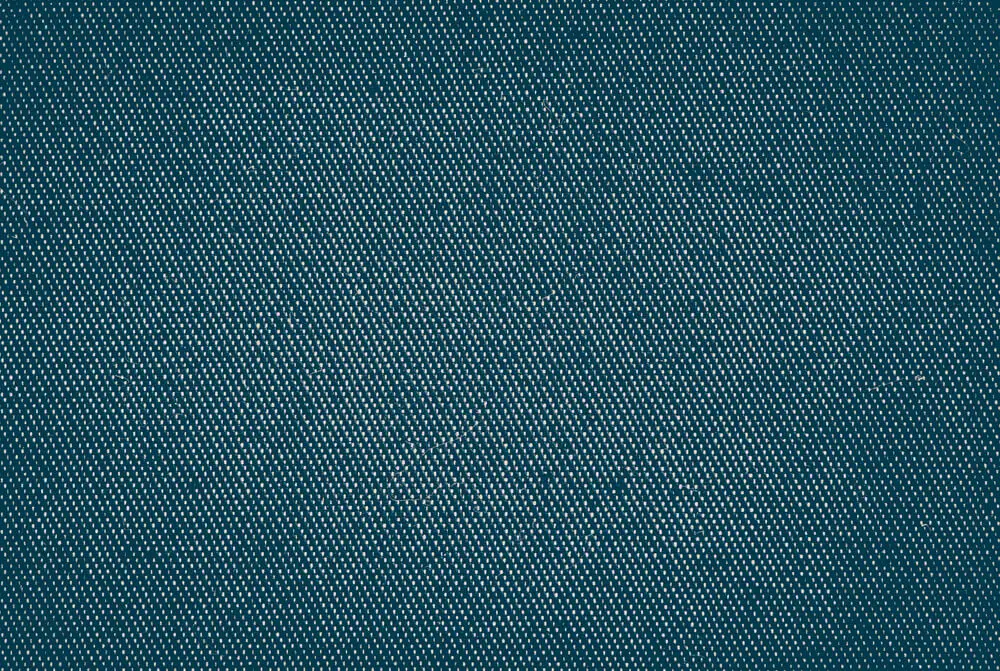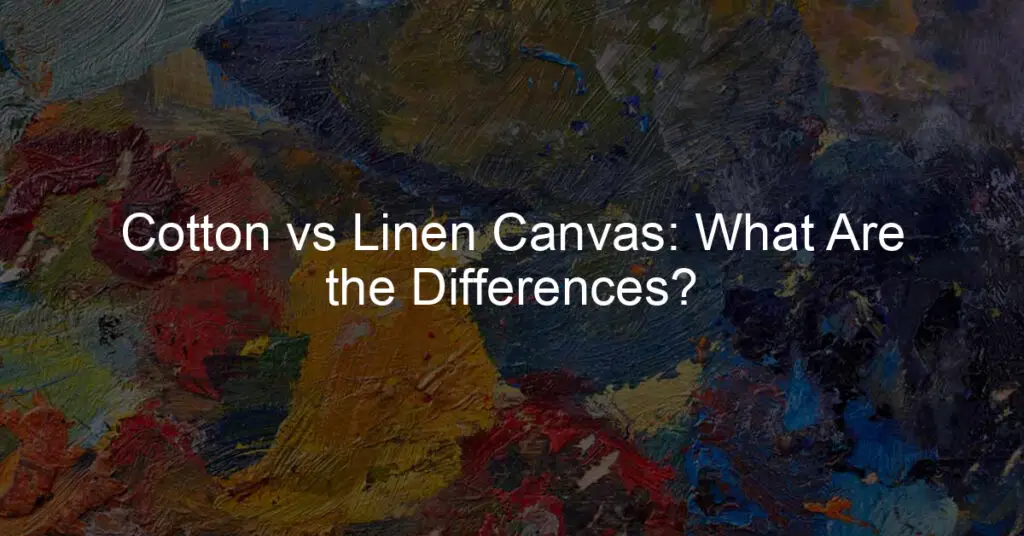When creating a painting or embarking on a creative project, the choice between cotton and linen canvas can significantly impact the outcome. Both materials offer their unique advantages and disadvantages, which ultimately influence factors such as durability, workability, and aesthetics.
This article will compare their qualities, shedding light on which material best suits different artistic needs and preferences.
Cotton canvas, made from versatile cotton plant fibers, is widely recognized for its affordability and ease of use. It’s even texture and smooth finish make it an excellent choice for beginners as well as experienced artists seeking consistent results.
On the other hand, linen canvas, made from flax plant fibers, is known for its sturdiness and longevity. With a naturally more organic texture, linen canvases provide an elevated level of sophistication and appeal for artists striving for higher-quality finishes.
Understanding the fundamental differences between cotton and linen canvases is crucial for artists, as each possesses distinct features that contribute to an artwork’s overall appearance and performance.
The following discussion will explore the pros and cons of using each material in detail, helping guide artists in selecting the best canvas for their next masterpiece.
Cotton vs. Linen Canvas: The Basics

Cotton Canvas
Cotton canvas is a popular choice for many artists due to its affordability and versatility. It is made from tightly woven cotton fibers that give it a smooth surface, which is suitable for various painting techniques. The durability and texture of cotton canvas make it suitable for both acrylic and oil paintings. Some features of cotton canvas include:
- Affordable: Cotton is generally less expensive than linen, making it an attractive option for beginners and budget-conscious artists.
- Easy to work with: The natural flexibility of cotton fibers allows for easy stretching and mounting on stretcher bars or other supports.
- Adaptable: The cotton canvas can be primed with various materials, including gesso, to create a surface with the desired absorbency and texture.
However, it is worth noting that cotton canvas is slightly less durable and may be prone to stretching or sagging over time.
Linen Canvas
Linen canvas, made from flax fibers, is regarded as a high-quality, professional-grade canvas. It has been used for centuries by renowned artists for its unique properties. Some key characteristics of linen canvas are:
- Strong and durable: Linen fibers have a high tensile strength, making it more resistant to wear and tear. As a result, linen canvas is less likely to stretch or sag, ensuring the longevity of the artwork.
- Smooth surface: The fine texture of linen offers a smooth surface, ideal for intricate details and various techniques, including glazing.
- Naturally non-absorbent: Linen is less absorbent than cotton, allowing for better color saturation and vibrancy in oil paintings.
Though linen canvas has several advantages, it does come with a higher price tag, which may be a consideration for some artists.
In summary, both cotton and linen canvas have their unique advantages, catering to different preferences and budgets. While cotton canvas is more affordable and versatile, linen canvas is known for its strength, durability, and smooth texture. The choice between the two ultimately depends on the artist’s priorities and the specific requirements of their work.
Materials and Manufacturing Process

Cotton Fabric
Cotton fabric is made from the cotton plant. The manufacturing process starts with harvesting the cotton and separating the fibers from the seeds. These fibers are then spun into threads and made into fabric.
Manufacturers prefer cotton for its affordability, availability, and ease of use in production. Cotton absorbs moisture well, and it’s relatively easy to stretch and prime for painting.
Key points of cotton fabric:
- Comes from the cotton plant
- Affordable and widely available
- Absorbs moisture well
Linen Fabric
Linen fabric, on the other hand, is derived from the flax plant. The plant’s fibers are extracted, spun into threads, and woven into fabric. Linen is known for its strength, durability, and resistance to environmental factors like mold and mildew.
Manufacturers appreciate linen’s rigidity, which makes it particularly suited for larger canvases. Linen fabric can also be tightly woven, allowing for intricate detail in the artwork.
Key points of linen fabric:
- Comes from the flax plant
- Strong, durable, and resistant to environmental factors
- Suited for larger canvases and intricate details
Texture and Surface Properties
The texture of Cotton Canvas
Cotton canvas has a unique texture that is typically softer and smoother compared to linen canvas. This is due to the nature of cotton fibers, which are shorter and more flexible than linen fibers. Cotton canvas offers a more consistent and even texture, making it suitable for various painting styles.
The surface of a cotton canvas often has a gentle, almost velvety feel, which can be especially appealing to certain artists.
The tooth of a cotton canvas refers to the amount of roughness or grip that it provides to the paintbrush. Generally, cotton canvas has a moderate tooth, providing a balanced amount of grip for paint application. However, it is possible to find cotton canvases with varying degrees of the tooth, ranging from very smooth to somewhat rough, similar to the feel of sandpaper. This allows artists to choose the appropriate tooth according to their technique and requirements.
The texture of Linen Canvas
Linen canvas, on the other hand, has a distinct and unique texture that is coarser and more robust than that of cotton canvas. The longer and stronger fibers of linen create a more pronounced texture with a noticeable weave pattern. The surface of linen canvas tends to be stiffer and less forgiving, which can be desirable for specific techniques and applications.
The tooth of a linen canvas is generally more aggressive, providing artists with a stronger grip for their brushwork. Linen’s tooth can vary from moderately rough to very coarse and sandpaper-like surfaces, giving painters ample options to suit their preferences or intentions. The increased tooth of linen canvas can lead to more expressive brushstrokes and a more dynamic overall appearance in the finished artwork.
In conclusion, both cotton and linen canvases have their unique texture and tooth qualities, and artists can choose the suitable type of canvas for their preferred painting style and desired outcomes.
Strength and Durability
Strength of Cotton Canvas

Cotton canvas is known for its strength and versatility. It is typically made from a plain weave of cotton fibers, which makes it relatively strong and resistant to damage. Cotton canvas is capable of withstanding moderate tension but may stretch over time, particularly when exposed to moisture.
One of the main advantages of cotton canvas is its cost-effective nature, making it a popular choice for artists and hobbyists. However, in terms of durability and longevity, cotton canvas may not be the best option for some. It is generally less resistant to humidity and temperature fluctuations and is more prone to warping compared to linen canvas.
Strength of Linen Canvas
Linen canvas, on the other hand, is known for its superior strength and rigidity. Made from fibers of the flax plant, linen canvas is incredibly durable and less likely to warp over time.
Linen fibers are also thinner and smoother than cotton fibers, creating a more even and tighter weave in the canvas material.
This natural strength of linen canvas makes it suitable for heavier and more demanding applications, such as large-scale paintings or pieces that will be exposed to fluctuating conditions.
The high tensile strength of linen also ensures that it can support a significant amount of paint without the risk of tearing or sagging.
Despite its increased durability and longevity, linen canvas tends to be more expensive than cotton canvas, which may be a deciding factor for some artists.
To summarize the main points:
- Cotton Canvas:
- Strong and versatile
- Less resistant to humidity and temperature changes
- More prone to warping
- Cost-effective
- Linen Canvas:
- Superior strength and rigidity
- Durable and less likely to warp
- Suitable for heavier applications
- Higher cost
Stretched Canvases and Stretcher Bars
Stretched canvases provide a taut surface ideal for painting. The canvas, made of either cotton or linen, needs to be stretched over a wooden frame using stretcher bars. The stretching process ensures proper tension and reduces the impact of contraction and expansion due to changes in humidity.
Cotton Canvas Stretching
Cotton canvas is known for its easy stretching and affordability. To stretch a cotton canvas, follow these steps:
- Assemble the stretcher bars to form the wooden frame. Make sure the corners are square, and the frame is sturdy.
- Cut the cotton canvas to size, leaving enough material to fold over the edges of the frame.
- Staple the canvas to the frame, starting from the center of each side and working outwards. This helps to maintain even tension across the canvas.
- Fold and staple the canvas at each corner, smoothing out any wrinkles.
When stretching cotton canvas, remember that it may slightly contract or expand due to changes in humidity. A quality wooden frame will help maintain the canvas tension.
Linen Canvas Stretching
Linen canvas is considered more upscale and is favored for its durability and texture. However, it can be more challenging to stretch due to its lower elasticity. Here are the steps to stretch a linen canvas:
- Assemble the stretcher bars to form a stable and square wooden frame.
- Cut the linen canvas, leaving sufficient material to fold over the edges of the frame.
- Dampen the linen slightly with water to make it more pliable before stretching.
- Staple the canvas, beginning at the center of each side and working outwards, maintaining tension as you go.
- Fold and staple the canvas at the corners, ensuring a smooth and wrinkle-free surface.
Keep in mind that linen canvas may experience more significant contraction and expansion compared to cotton canvas. Using a quality wooden frame and proper stretching techniques can help maintain better tension over time.
Priming and Painting
When it comes to priming, both cotton and linen canvases generally need to be primed before painting begins so they become less absorbent. Priming a canvas usually involves applying a layer of gesso. This provides a proper painting surface and prevents the paint from soaking into the fibers of the canvas.
There are two main types of gesso: acrylic and oil-based. Acrylic gesso is suitable for acrylic painting, while oil-based gesso should be used for oil painting. Traditionally, painters have preferred to use oils on linen canvas due to its tight weave and durability. However, acrylic paint can also be used on linen, provided it has been properly primed with acrylic gesso. Cotton canvas is more commonly associated with acrylic painting but can support oils as well.
It is important to note the difference in sizing the canvas when using oils or acrylic paint. Before applying gesso, a canvas should be sized. For oil painting, artists should use a traditional sizing agent like rabbit skin glue, while acrylic painting requires a synthetic sizing agent, often found in acrylic gesso.
Cotton canvas is more absorbent than linen, so using an appropriate layer of gesso is crucial for better paint adhesion and to prevent the paint from seeping through the fabric.
Linen, on the other hand, is less absorbent than cotton, reducing the need for multiple layers of gesso.
In terms of painting technique, the texture of the canvas can affect the brushwork and paint application. Linen tends to have a smoother texture than cotton, which makes it more suitable for fine, detailed work. Cotton canvas has a rougher surface, allowing for bolder strokes and texture building.
In summary, cotton and linen canvases have their own advantages and requirements when it comes to priming and painting—both types of canvas benefit from being properly primed with gesso to create an ideal painting surface. Understanding the characteristics of each canvas type and choosing the appropriate gesso and sizing agent will greatly impact the final artwork.
Suitability for Different Art Styles
Cotton Canvas for Different Styles
Cotton canvas is a popular choice among many painters due to its smooth texture and affordability. The smoother surface makes it suitable for fine detail work, allowing artists to create intricate designs with their brushes effortlessly. Moreover, its flexible nature gives painters the ability to experiment with various drawing styles, making it an ideal choice for both beginners and experienced artists.
Cotton canvas is compatible with a variety of paint types, including acrylics and oils, providing a versatile platform for different painting approaches. However, due to its less rigid structure compared to linen, it may not be the best option for extremely heavy paint applications or large-scale works.
Linen Canvas for Different Styles
Linen canvas, on the other hand, offers more rigidity and durability, making it preferred by some painters for larger and more complex artworks. The texture of linen canvas is generally rougher than cotton, which can be desirable for artists who prefer working with a more pronounced texture to enhance their painting style.
Linen canvas is well-suited for fine detail work thanks to its tight weave and ability to maintain a rigid surface even under heavy paint applications. This characteristic allows painters to create crisp edges and well-defined brush strokes, which is particularly advantageous for styles that require a high level of precision.
In summary, both cotton and linen canvases have unique traits that make them suitable for different art styles. Cotton offers a smooth and flexible surface, while linen provides rigidity and pronounced texture. The choice ultimately depends on the painter’s preferences, materials, and the artwork’s requirements.
Cost Considerations
When discussing cotton vs. linen canvas, it is essential to consider the costs associated with each material. Both of these materials cater to varying budgets and preferences, and understanding the expenses linked to each can help you make an informed decision.
Cotton canvas is known to be more affordable than linen. Due to its lower production costs, cotton canvas is an attractive option for artists who require a budget-friendly choice without compromising on quality. The affordability of cotton canvas has also made it the go-to material for many hobbyists, emerging artists, and those working with a limited budget.
On the other hand, linen canvas is typically more expensive. Although it comes with a higher price tag, the benefits that accompany linen, such as its durability, longevity, and distinct texture, may justify the investment for some artists. Linen is generally considered a high-quality and professional-grade material, preferred by many accomplished artists for its undeniable advantages.
Exploring different canvas price points can provide valuable insights into the world of canvas materials. Here’s a comparison table highlighting the relative costs of cotton and linen canvases:
| Canvas Type | Cost Level |
|---|---|
| Cotton Canvas | Affordable |
| Linen Canvas | Expensive |
It’s worth noting that professional-grade cotton canvases are available, offering higher-quality materials at a moderately higher cost than regular cotton canvases. These canvases can be an excellent investment for artists looking for a middle ground between affordability and quality.
In summary, when evaluating cotton and linen canvas costs, both materials cater to a wide range of preferences and budgets. Cotton canvas tends to be more affordable, making it suitable for those with limited means or those just starting in art. On the other hand, linen canvas offers a high-quality, professional-grade option for more experienced artists willing to invest in their materials.
Environmental Impact and Sustainability
Sustainable Cotton Production
Cotton is a popular material for canvas due to its affordability and versatility. However, conventional cotton farming has several negative environmental impacts, including excessive water consumption, pesticide use, and soil degradation. In recent years, there has been a push toward sustainable cotton production. This involves practices such as:
- Organic farming: Avoiding synthetic fertilizers and pesticides and using natural alternatives instead.
- Water conservation: Implementing efficient irrigation methods, such as drip irrigation, to reduce water waste.
- Crop rotation: Alternating cotton crops with other plants to maintain soil fertility and prevent pest buildup.
- Fair labor practices: Ensuring workers receive fair wages and safe working conditions.
These practices help reduce the environmental impact of cotton production and contribute to a more sustainable canvas industry.
Sustainable Linen Production
Linen, made from the flax plant, is another popular canvas material. It is often considered more eco-friendly than cotton for several reasons:
- Lower resource consumption: Flax requires less water, fertilizer, and pesticide inputs compared to cotton.
- Biodegradable: Linen is a natural fiber and will decompose over time, reducing its environmental footprint.
- Local production: Flax is commonly grown and processed in Europe, which reduces the carbon emissions associated with transportation.
Flax farming also supports biodiversity, as it attracts pollinators and provides a habitat for various organisms. However, linen production can still have some negative environmental impacts, such as the use of chemicals in fiber processing. To further improve sustainability, the linen industry can adopt practices such as:
- Organic certification: Choosing flax fibers that are produced without the use of harmful chemicals.
- Low-impact processing: Utilizing more environmentally friendly methods for fiber extraction and fabric production.
By implementing these sustainable practices, both cotton and linen canvas manufacturers can contribute to a more eco-conscious future.
Notable Uses of Cotton and Linen Canvases
Cotton and linen canvases have a wide range of applications thanks to their versatile properties. Both materials are widely used in various industries and offer unique benefits.
Painting: Cotton and linen canvases are the go-to materials for artists. Cotton canvases, due to their affordability and accessibility, are often used by beginners and hobbyists. Meanwhile, linen canvases are more expensive but are preferred by professional artists for their durability and finer texture.
Bags and Handbags: Cotton canvas is a popular choice for making bags and handbags thanks to its durability and cost-effectiveness. Linen canvas, on the other hand, is used for creating higher-end bags and handbags, offering a refined look and feel.
Furniture: Both cotton and linen canvases find use in the furniture industry. They serve as comfortable and stylish upholstery materials. Cotton canvas is commonly found in cushion covers, while linen canvas is used for more luxurious upholstery, such as in sofas and armchairs.
Construction: Linen canvas is known for its strength and is, therefore, used in various construction applications. It can be employed as reinforcement material in plaster walls and ceilings or used as a base layer for flooring.
Shoes: Cotton canvas is a popular material for manufacturing shoes, particularly for casual and athletic footwear. It offers breathability, durability, and cost-effectiveness. Linen canvas, although less common in shoes, is also employed in high-end footwear for its refined appearance and breathability.
Canvas Material: The waterproof canvas fabric comes in handy in a range of applications, including outdoor furniture, tents, and awnings. The waterproof properties of these fabrics are achieved through a treatment process that makes them resistant to water, ensuring longevity in outdoor settings.
In summary, cotton and linen canvases serve a variety of purposes across industries. Their unique properties make them suitable for different applications, from painting and fashion to construction and furniture.
Frequently Asked Questions
What are the main differences between cotton and linen canvas?
Cotton canvas is made from woven cotton fibers, is lightweight, and has a slightly soft texture. Linen canvas, on the other hand, is made from flax fibers, is heavier, and has a more relaxed, textured surface.
Which material is better for oil painting: cotton or linen?
Both cotton and linen canvases can be used for oil painting. However, linen canvas is considered superior in terms of oil absorbency and durability. The natural properties of linen fibers allow better adhesion, reducing the chances of paint flaking over time.
How does the durability of cotton canvas compare to linen canvas?
Linen canvas is more durable than cotton canvas, mainly due to the natural strength and flexibility of flax fibers. It’s less prone to stretch over time and better resists deformation from moisture or changes in temperature.
What are the advantages of using linen canvas for acrylic painting?
Linen canvas offers excellent paint adhesion and a unique texture, making it a suitable choice for acrylic painting. However, cotton canvas is also a popular option for acrylics, as it absorbs the paint well and has a more uniform surface.
How do linen and cotton canvas prices compare?
Linen canvas is generally more expensive than cotton canvas due to the higher production costs and the superior properties of linen fibers. The higher price of linen canvas is often justified by its durability and traditional, highly-valued texture.
Are primed linen canvases recommended for specific types of art?
Primed linen canvases are typically recommended for oil paintings or works in which long-term preservation is essential, as they provide better durability and archival qualities. Additionally, some artists prefer the unique, textured surface of linen for creating expressive or detailed artwork.


















